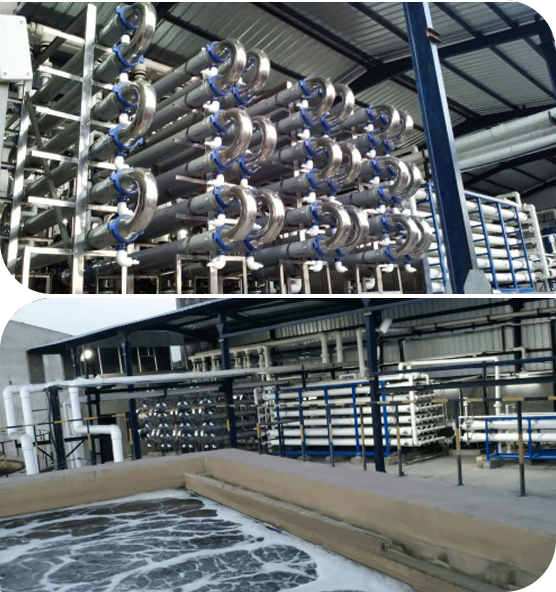
Waterman Engineers Australia is without doubt one of the top makers of Zero Liquid Discharge process. A ZLD procedure is a therapy procedure which can be employed to remove all of the liquid squander from the technique. The purpose of ZLD water treatment is to reduce wastewater economically and deliver potable drinking water that is certainly suit for regular use. Zero discharge system is a complicated treatment method technique that comprises ultrafiltration, reverse osmosis, evaporation and fractional electro deionization. And we've been a very well-identified provider of ZLD devices.
In many Industries, which include electricity, oil & gas, chemical compounds, mining and Other individuals, a great deal of wastewater is produced that should be managed. Conventionally, this discharge of wastewater is done by using a plant outfall into a area water overall body like an evaporation pond, or in some instances deep perfectly injected. These methods produce several environmental problems by the public in many areas of the world, as water is often a scarce resource and its management must be monitored. These fears have resulted within the establishment of ZLD procedures by lots of industries to lessen their environmental footprint and boost sustainability. And, Waterman Engineers Australia are ideal ZLD suppliers you can find for this system.
Homes OF ZERO LIQUID DISCHARGE Process
The Attributes of the Zero Liquid Discharge system may vary dependant upon the unique design and engineering utilised. On the other hand, some prevalent Houses of ZLD units include things like:
H2o Conservation: One of the primary targets of ZLD units is to preserve drinking water by minimizing the discharge of liquid squander in the natural environment.
Significant Drinking water Purity: ZLD methods are designed to produce superior-excellent drinking water that's free from impurities and contaminants, that makes them ideal for use in several industrial processes.
Flexibility: ZLD devices are sometimes developed to support a broad number of input liquid streams, that makes them adaptable and suitable for use in several industries.
Sophisticated Wastewater Procedure: Zero liquid discharge programs use Sophisticated wastewater cure methods to clear away impurities and contaminants in the effluent, manufacturing higher-excellent water.
Waste Reduction: ZLD devices help lessen squander by decreasing the amount of liquid squander that should be disposed of and by producing a concentrated, sound squander product that can be securely disposed of.
Electricity Performance: ZLD systems could be Strength-intense mainly because of the higher Vitality necessities of evaporation and other wastewater therapy processes. Nevertheless, improvements Zld System Manufacturer Zero Liquid Discharge System in technological innovation are building Zero liquid discharge units extra Electrical power-economical and price-productive.
Waterman Engineers Australia manufactures Zero Liquid Discharge (ZLD) units meant to clear away all liquid squander, aiming to supply potable water and minimize environmental impact. Their ZLD units ordinarily include things like ultrafiltration, reverse osmosis, evaporation, and fractional electro deionization. Critical technologies used are Slipping Film Brine Concentrators, Compelled Circulation Crystallizer, and Many others, that has a two-phase process of pre-focus and evaporation/crystallization to Recuperate and reuse h2o. These programs are adaptable to various industries, emphasizing h2o conservation, substantial water purity, waste reduction, and energy performance. Technical requirements are different and customizable, considering components like water supply, flow fee, and feed h2o good quality.
The necessity for Zero Liquid Discharge (ZLD) techniques occurs in the requirement to deal with environmental issues connected to water scarcity and pollution. In industries like electric power, oil & gas, and mining, extensive quantities of wastewater are created. Typically, this wastewater is discharged into bodies of drinking water, producing pollution and depleting clear drinking water means. ZLD methods goal to reduce these impacts by managing and recycling wastewater within the industrial method, therefore conserving drinking water, lessening squander, and advertising sustainability.
When contemplating the specialized requirements of a Zero Liquid Discharge (ZLD) technique, vital areas to concentrate on consist of the water source it'll deal with, the method's movement price, the quality of feed water, the levels of procedure included, the recovery charge of water, techniques for focus disposal, products of development, working situations, and program automation and Manage. These factors make sure the technique's usefulness, durability, and performance in dealing with and recycling industrial wastewater.
Zero Liquid Discharge (ZLD) plants present Positive aspects including h2o conservation, waste reduction, and air pollution avoidance, contributing to environmental sustainability. They're relevant in industries like energy technology, oil and gas, substances, and mining, the place they help in taking care of industrial wastewater efficiently, reducing the ecological footprint, and complying with rigorous environmental regulations. These devices are vital in spots going through h2o scarcity and for industries aiming to enhance their sustainability and operational effectiveness.
FAQs for a Zero Liquid Discharge (ZLD) technique often deal with its operational concepts, Price-performance, routine maintenance needs, environmental impression, applicability across different industries, and regulatory compliance. These issues help consumers have an understanding of the method's Positive aspects, complex requires, and suitability for his or her particular wastewater management wants.
one. Zero Liquid Discharge (ZLD) is often a wastewater treatment procedure created to remove all liquid squander.
2. The technique's parts are motivated by the particular industrial course of action, wastewater composition, and regulatory necessities.
three. Effluent cure crops clear away pollutants from textile effluents to forestall environmental contamination.
four. Strengths include things like drinking water conservation, pollution reduction, and regulatory compliance.
5. The goal is to attenuate environmental effects by recycling drinking water and minimizing waste.
6-nine. Effluent treatment method plants are stages in wastewater procedure: Most important (physical separation), secondary (Organic treatment), and tertiary (Sophisticated treatment).
ten. Unit functions include things like filtration, sedimentation, biological treatment, and disinfection.
eleven. Restricting parameters are aspects that impact the remedy's efficiency, like pH and contaminant focus.
12. Style and design issues include things like movement price, effluent composition, and wished-for good quality of handled h2o.